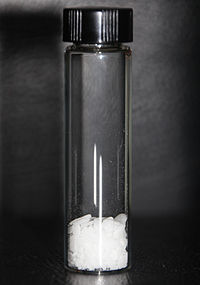Triphenyl phosphine
 |
|
 |
|
 |
|
 |
|
| Names | |
|---|---|
|
IUPAC name
Triphenylphosphane
|
|
| Identifiers | |
|
603-35-0 |
|
| 3D model (Jmol) | Interactive image |
| ChemSpider |
11283 |
| ECHA InfoCard | 100.009.124 |
| EC Number | 210-036-0 |
| PubChem | 11776 |
| RTECS number | SZ3500000 |
|
|
|
|
| Properties | |
| C18H15P | |
| Molar mass | 262.29 g·mol−1 |
| Appearance | White Solid |
| Density | 1.1 g cm−3, solid |
| Melting point | 80 °C (176 °F; 353 K) |
| Boiling point | 377 °C (711 °F; 650 K) |
| Insoluble | |
| Solubility | organic solvents |
| Acidity (pKa) | 7.61 (pKa of conjugate acid in acetonitrile) |
| -166.8·10−6 cm3/mol | |
|
Refractive index (nD)
|
1.59; εr, etc. |
| Structure | |
| Pyramidal | |
| 1.4 - 1.44 D | |
| Hazards | |
| Safety data sheet | JT Baker |
|
EU classification (DSD)
|
Not Listed |
| R-phrases | R20 R22 R40 R43 R50 R53 |
| S-phrases | S36 S37 S45 S57 S60 |
| Flash point | 180 °C (356 °F; 453 K) |
| Related compounds | |
|
Related tertiary phosphines
|
Trimethylphosphine Phosphine |
|
Related compounds
|
Triphenylamine Triphenylarsine Triphenylphosphine oxide Triphenylphosphine sulfide Triphenylphosphine dichloride Triphenylphosphine selenide, Pd(PPh3)4 |
|
Except where otherwise noted, data are given for materials in their standard state (at 25 °C [77 °F], 100 kPa).
|
|
|
|
|
| Infobox references | |
Triphenylphosphine (IUPAC name: triphenylphosphane) is a common organophosphorus compound with the formula P(C6H5)3 - often abbreviated to PPh3 or Ph3P. It is widely used in the synthesis of organic and organometallic compounds. PPh3 exists as relatively air stable, colorless crystals at room temperature. It dissolves in non-polar organic solvents such as benzene and diethyl ether.
Triphenylphosphine is a relatively inexpensive substance. It can be prepared in the laboratory by treatment of phosphorus trichloride with phenylmagnesium bromide or phenyllithium. The industrial synthesis involves the reaction between phosphorus trichloride, chlorobenzene, and sodium.:
Triphenylphosphine undergoes slow oxidation by air to give triphenylphosphine oxide, Ph3PO:
This impurity can be removed by recrystallisation of PPh3 from either hot ethanol or hot isopropanol. This method capitalizes on the fact that OPPh3 is more polar and hence more soluble in polar solvents than PPh3.
Triphenylphosphine abstracts sulfur from polysulfide compounds, episulfides, and elemental sulfur. Simple organosulfur compounds such as thiols and thioethers are unreactive, however. The phosphorus-containing product is triphenylphosphine sulfide, Ph3PS. This reaction can be employed to assay the "labile" S0 content of a sample, say vulcanized rubber. Triphenylphosphine selenide, Ph3PSe, may be easily prepared via treatment of PPh3 with red (alpha-monoclinic) Se. Salts of selenocyanate, SeCN−, are used as the Se0 source. PPh3 can also form an adduct with Te, although this adduct primarily exists as (Ph3P)2Te rather than PPh3Te.
...
Wikipedia
